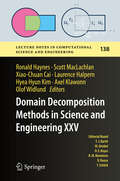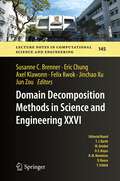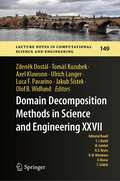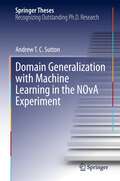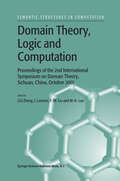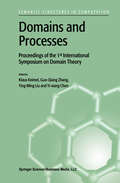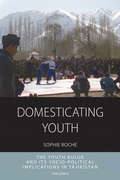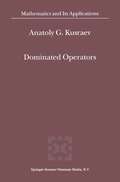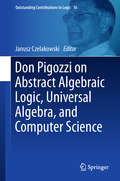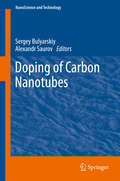- Table View
- List View
Domain Decomposition Methods in Science and Engineering XXV (Lecture Notes in Computational Science and Engineering #138)
These are the proceedings of the 25th International Conference on Domain Decomposition Methods in Science and Engineering, which was held in St. John's, Newfoundland, Canada in July 2018. Domain decomposition methods are iterative methods for solving the often very large systems of equations that arise when engineering problems are discretized, frequently using finite elements or other modern techniques. These methods are specifically designed to make effective use of massively parallel, high-performance computing systems. The book presents both theoretical and computational advances in this domain, reflecting the state of art in 2018.
Domain Decomposition Methods in Science and Engineering XXVI (Lecture Notes in Computational Science and Engineering #145)
These are the proceedings of the 26th International Conference on Domain Decomposition Methods in Science and Engineering, which was hosted by the Chinese University of Hong Kong and held online in December 2020.Domain decomposition methods are iterative methods for solving the often very large systems of equations that arise when engineering problems are discretized, frequently using finite elements or other modern techniques. These methods are specifically designed to make effective use of massively parallel, high-performance computing systems.The book presents both theoretical and computational advances in this domain, reflecting the state of art in 2020.
Domain Decomposition Methods in Science and Engineering XXVII (Lecture Notes in Computational Science and Engineering #149)
These are the proceedings of the 27th International Conference on Domain Decomposition Methods in Science and Engineering, which was held in Prague, Czech Republic, in July 2022.Domain decomposition methods are iterative methods for solving the often very large systems of equations that arise when engineering problems are discretized, frequently using finite elements or other modern techniques. These methods are specifically designed to make effective use of massively parallel, high-performance computing systems.The book presents both theoretical and computational advances in this domain, reflecting the state of art in 2022.
Domain-driven Design With Java - A Practitioner's Guide: Create Simple, Elegant, And Valuable Software Solutions For Complex Business Problems
by Premanand Chandrasekaran Karthik KrishnanCreate simple, elegant, and valuable software solutions for complex business problems
Domain Generalization with Machine Learning in the NOvA Experiment (Springer Theses)
by Andrew T.C. SuttonThis thesis presents significant advances in the use of neural networks to study the properties of neutrinos. Machine learning tools like neural networks (NN) can be used to identify the particle types or determine their energies in detectors such as those used in the NOvA neutrino experiment, which studies changes in a beam of neutrinos as it propagates approximately 800 km through the earth. NOvA relies heavily on simulations of the physics processes and the detector response; these simulations work well, but do not match the real experiment perfectly. Thus, neural networks trained on simulated datasets must include systematic uncertainties that account for possible imperfections in the simulation. This thesis presents the first application in HEP of adversarial domain generalization to a regression neural network. Applying domain generalization to problems with large systematic variations will reduce the impact of uncertainties while avoiding the risk of falsely constraining the phase space. Reducing the impact of systematic uncertainties makes NOvA analysis more robust, and improves the significance of experimental results.
Domain-Specific Knowledge Graph Construction (SpringerBriefs in Computer Science)
by Mayank KejriwalThe vast amounts of ontologically unstructured information on the Web, including HTML, XML and JSON documents, natural language documents, tweets, blogs, markups, and even structured documents like CSV tables, all contain useful knowledge that can present a tremendous advantage to the Artificial Intelligence community if extracted robustly, efficiently and semi-automatically as knowledge graphs. Domain-specific Knowledge Graph Construction (KGC) is an active research area that has recently witnessed impressive advances due to machine learning techniques like deep neural networks and word embeddings. This book will synthesize Knowledge Graph Construction over Web Data in an engaging and accessible manner. The book will describe a timely topic for both early -and mid-career researchers. Every year, more papers continue to be published on knowledge graph construction, especially for difficult Web domains. This work would serve as a useful reference, as well as an accessible but rigorous overview of this body of work. The book will present interdisciplinary connections when possible to engage researchers looking for new ideas or synergies. This will allow the book to be marketed in multiple venues and conferences. The book will also appeal to practitioners in industry and data scientists since it will have chapters on both data collection, as well as a chapter on querying and off-the-shelf implementations. The author has, and continues to, present on this topic at large and important conferences. He plans to make the powerpoint he presents available as a supplement to the work. This will draw a natural audience for the book. Some of the reviewers are unsure about his position in the community but that seems to be more a function of his age rather than his relative expertise. I agree with some of the reviewers that the title is a little complicated. I would recommend “Domain Specific Knowledge Graphs”.
Domain-Specific Languages in R: Advanced Statistical Programming
by Thomas MailundGain an accelerated introduction to domain-specific languages in R, including coverage of regular expressions. This compact, in-depth book shows you how DSLs are programming languages specialized for a particular purpose, as opposed to general purpose programming languages. Along the way, you’ll learn to specify tasks you want to do in a precise way and achieve programming goals within a domain-specific context. Domain-Specific Languages in R includes examples of DSLs including large data sets or matrix multiplication; pattern matching DSLs for application in computer vision; and DSLs for continuous time Markov chains and their applications in data science. After reading and using this book, you’ll understand how to write DSLs in R and have skills you can extrapolate to other programming languages.What You'll LearnProgram with domain-specific languages using RDiscover the components of DSLsCarry out large matrix expressions and multiplications Implement metaprogramming with DSLsParse and manipulate expressions Who This Book Is ForThose with prior programming experience. R knowledge is helpful but not required.
Domain Theory, Logic and Computation: Proceedings of the 2nd International Symposium on Domain Theory, Sichuan, China, October 2001 (Semantics Structures in Computation #3)
by Guo-Qiang Guo-Qiang Zhang J. Lawson Ying Ming Ying Ming Liu M. K. LuoDomains are mathematical structures for information and approximation; they combine order-theoretic, logical, and topological ideas and provide a natural framework for modelling and reasoning about computation. The theory of domains has proved to be a useful tool for programming languages and other areas of computer science, and for applications in mathematics. Included in this proceedings volume are selected papers of original research presented at the 2nd International Symposium on Domain Theory in Chengdu, China. With authors from France, Germany, Great Britain, Ireland, Mexico, and China, the papers cover the latest research in these sub-areas: domains and computation, topology and convergence, domains, lattices, and continuity, and representations of domains as event and logical structures. Researchers and students in theoretical computer science should find this a valuable source of reference. The survey papers at the beginning should be of particular interest to those who wish to gain an understanding of some general ideas and techniques in this area.
Domains and Processes: Proceedings of the 1st International Symposium on Domain Theory Shanghai, China, October 1999 (Semantics Structures in Computation #1)
by Klaus Keimel Guo-Qiang Guo-Qiang Zhang Ying Ming Ying Ming Liu Yixiang Yixiang ChenDomain theory is a rich interdisciplinary area at the intersection of logic, computer science, and mathematics. This volume contains selected papers presented at the International Symposium on Domain Theory which took place in Shanghai in October 1999. Topics of papers range from the encounters between topology and domain theory, sober spaces, Lawson topology, real number computability and continuous functionals to fuzzy modelling, logic programming, and pi-calculi. This book is a valuable reference for researchers and students interested in this rapidly developing area of theoretical computer science.
Domesticating Youth: Youth Bulges and their Socio-political Implications in Tajikistan (Integration and Conflict Studies #8)
by Sophie RocheMost of the Muslim societies of the world have entered a demographic transition from high to low fertility, and this process is accompanied by an increase in youth vis-à-vis other age groups. Political scientists and historians have debated whether such a “youth bulge” increases the potential for conflict or whether it represents a chance to accumulate wealth and push forward social and technological developments. This book introduces the discussion about youth bulge into social anthropology using Tajikistan, a post-Soviet country that experienced civil war in the 1990s, which is in the middle of such a demographic transition. Sophie Roche develops a social anthropological approach to analyze demographic and political dynamics, and suggests a new way of thinking about social change in youth bulge societies.
Domesticating Youth: Youth Bulges and their Socio-political Implications in Tajikistan (Integration and Conflict Studies #8)
by Sophie RocheMost of the Muslim societies of the world have entered a demographic transition from high to low fertility, and this process is accompanied by an increase in youth vis-à-vis other age groups. Political scientists and historians have debated whether such a “youth bulge” increases the potential for conflict or whether it represents a chance to accumulate wealth and push forward social and technological developments. This book introduces the discussion about youth bulge into social anthropology using Tajikistan, a post-Soviet country that experienced civil war in the 1990s, which is in the middle of such a demographic transition. Sophie Roche develops a social anthropological approach to analyze demographic and political dynamics, and suggests a new way of thinking about social change in youth bulge societies.
Dominated Operators (Mathematics and Its Applications #519)
by A.G. KusraevThe notion of a dominated or rnajorized operator rests on a simple idea that goes as far back as the Cauchy method of majorants. Loosely speaking, the idea can be expressed as follows. If an operator (equation) under study is dominated by another operator (equation), called a dominant or majorant, then the properties of the latter have a substantial influence on the properties of the former . Thus, operators or equations that have "nice" dominants must possess "nice" properties. In other words, an operator with a somehow qualified dominant must be qualified itself. Mathematical tools, putting the idea of domination into a natural and complete form, were suggested by L. V. Kantorovich in 1935-36. He introduced the funda mental notion of a vector space normed by elements of a vector lattice and that of a linear operator between such spaces which is dominated by a positive linear or monotone sublinear operator. He also applied these notions to solving functional equations. In the succeedingyears many authors studied various particular cases of lattice normed spaces and different classes of dominated operators. However, research was performed within and in the spirit of the theory of vector and normed lattices. So, it is not an exaggeration to say that dominated operators, as independent objects of investigation, were beyond the reach of specialists for half a century. As a consequence, the most important structural properties and some interesting applications of dominated operators have become available since recently.
Domination Games Played on Graphs (SpringerBriefs in Mathematics)
by Boštjan Brešar Michael A. Henning Sandi Klavžar Douglas F. RallThis concise monograph present the complete history of the domination game and its variants up to the most recent developments and will stimulate research on closely related topics, establishing a key reference for future developments. The crux of the discussion surrounds new methods and ideas that were developed within the theory, led by the imagination strategy, the Continuation Principle, and the discharging method of Bujtás, to prove results about domination game invariants. A toolbox of proof techniques is provided for the reader to obtain results on the domination game and its variants. Powerful proof methods such as the imagination strategy are presented. The Continuation Principle is developed, which provides a much-used monotonicity property of the game domination number. In addition, the reader is exposed to the discharging method of Bujtás. The power of this method was shown by improving the known upper bound, in terms of a graph's order, on the (ordinary) domination number of graphs with minimum degree between 5 and 50. The book is intended primarily for students in graph theory as well as established graph theorists and it can be enjoyed by anyone with a modicum of mathematical maturity.The authors include exact results for several families of graphs, present what is known about the domination game played on subgraphs and trees, and provide the reader with the computational complexity aspects of domination games. Versions of the games which involve only the “slow” player yield the Grundy domination numbers, which connect the topic of the book with some concepts from linear algebra such as zero-forcing sets and minimum rank. More than a dozen other related games on graphs and hypergraphs are presented in the book. In all these games there are problems waiting to be solved, so the area is rich for further research. The domination game belongs to the growing family of competitive optimization graph games. The game is played by two competitors who take turns adding a vertex to a set of chosen vertices. They collaboratively produce a special structure in the underlying host graph, namely a dominating set. The two players have complementary goals: one seeks to minimize the size of the chosen set while the other player tries to make it as large as possible. The game is not one that is either won or lost. Instead, if both players employ an optimal strategy that is consistent with their goals, the cardinality of the chosen set is a graphical invariant, called the game domination number of the graph. To demonstrate that this is indeed a graphical invariant, the game tree of a domination game played on a graph is presented for the first time in the literature.
Domination in Graphs: Core Concepts (Springer Monographs in Mathematics)
by Teresa W. Haynes Stephen T. Hedetniemi Michael A. HenningThis monograph is designed to be an in-depth introduction to domination in graphs. It focuses on three core concepts: domination, total domination, and independent domination. It contains major results on these foundational domination numbers, including a wide variety of in-depth proofs of selected results providing the reader with a toolbox of proof techniques used in domination theory. Additionally, the book is intended as an invaluable reference resource for a variety of readerships, namely, established researchers in the field of domination who want an updated, comprehensive coverage of domination theory; next, researchers in graph theory who wish to become acquainted with newer topics in domination, along with major developments in the field and some of the proof techniques used; and, graduate students with interests in graph theory, who might find the theory and many real-world applications of domination of interest for masters and doctoral thesis topics. The focused coverage also provides a good basis for seminars in domination theory or domination algorithms and complexity. The authors set out to provide the community with an updated and comprehensive treatment on the major topics in domination in graphs. And by Jove, they’ve done it! In recent years, the authors have curated and published two contributed volumes: Topics in Domination in Graphs, © 2020 and Structures of Domination in Graphs, © 2021. This book rounds out the coverage entirely. The reader is assumed to be acquainted with the basic concepts of graph theory and has had some exposure to graph theory at an introductory level. As graph theory terminology sometimes varies, a glossary of terms and notation is provided at the end of the book.
Don Pigozzi on Abstract Algebraic Logic, Universal Algebra, and Computer Science (Outstanding Contributions to Logic #16)
by Janusz CzelakowskiThis book celebrates the work of Don Pigozzi on the occasion of his 80th birthday. In addition to articles written by leading specialists and his disciples, it presents Pigozzi’s scientific output and discusses his impact on the development of science. The book both catalogues his works and offers an extensive profile of Pigozzi as a person, sketching the most important events, not only related to his scientific activity, but also from his personal life. It reflects Pigozzi's contribution to the rise and development of areas such as abstract algebraic logic (AAL), universal algebra and computer science, and introduces new scientific results. Some of the papers also present chronologically ordered facts relating to the development of the disciplines he contributed to, especially abstract algebraic logic. The book offers valuable source material for historians of science, especially those interested in history of mathematics and logic.
Donaldson Type Invariants for Algebraic Surfaces: Transition of Moduli Stacks (Lecture Notes in Mathematics #1972)
by Takuro MochizukiIn this monograph, we de?ne and investigate an algebro-geometric analogue of Donaldson invariants by using moduli spaces of semistable sheaves with arbitrary ranks on a polarized projective surface. We may expect the existence of interesting “universal relations among invariants”, which would be a natural generalization of the “wall-crossing formula” and the “Witten conjecture” for classical Donaldson invariants. Our goal is to obtain a weaker version of such relations, in other brief words, to describe a relation as the sum of integrals over the products of m- uli spaces of objects with lower ranks. Fortunately, according to a recent excellent work of L. Gottsche, ¨ H. Nakajima and K. Yoshioka, [53], a wall-crossing formula for Donaldson invariants of projective surfaces can be deduced from such a weaker result in the rank two case. We hope that our work in this monograph would, at least tentatively, provides a part of foundation for the further study on such universal relations. In the rest of this preface, we would like to explain our motivation and some of important ingredients of this study. See Introduction for our actual problems and results. Donaldson Invariants Let us brie?y recall Donaldson invariants. We refer to [22] for more details and precise. We also refer to [37], [39], [51] and [53]. LetX be a compact simply con- ? nected oriented real 4-dimensional C -manifold with a Riemannian metric g. Let P be a principalSO(3)-bundle on X.
Don't Be Afraid of Physics: Quantum Mechanics, Relativity and Cosmology for Everyone
by Ross Barrett Pier Paolo DelsantoWith the aid of entertaining short stories, anecdotes, lucid explanations and straight-forward figures, this book challenges the perception that the world of physics is inaccessible to the non-expert. Beginning with Neanderthal man, it traces the evolution of human reason and understanding from paradoxes and optical illusions to gravitational waves, black holes and dark energy. On the way, it provides insights into the mind-boggling advances at the frontiers of physics and cosmology. Unsolved problems and contradictions are highlighted, and contentious issues in modern physics are discussed in a non-dogmatic way in a language comprehensible to the non-scientist. It has something for everyone.
Doping of Carbon Nanotubes (NanoScience and Technology)
by Sergey Bulyarskiy Alexandr SaurovThis book addresses the control of electronic properties of carbon nanotubes. It presents thermodynamic calculations of the formation of impurities and defects in the interaction of nanotubes with hydrogen, oxygen, nitrogen and boron, based on theoretical models of the formation of defects in carbon nanotubes. It is shown that doping and adsorption lead to changes in the electronic structure of the tubes as well as to the appearance of impurity states in the HOMO-LUMO gap. The book presents examples of specific calculations for doping of carbon nanotubes with oxygen, hydrogen, nitrogen and boron, together with numerous experimental results and a comparison with the author’s thermodynamic calculations. Possible directions of the technological processes of optimization are pointed out, as well as the perspectives of p-n-transition creation with the help of carbon nanotube arrays. The results presented were derived from the physics of the processes and a theoretical model of the technological processes. Though a wealth of empirical information on doping nanotubes has been accumulated in the scientific literature, what is lacking is a theoretical model for their analysis. As such, the book develops a thermodynamic model of the self-organization of structural elements in multicomponent systems – including carbon nanotubes, clusters and precipitates in condensed matter – and subsequently adapts it to the doping of carbon nanotubes. This approach allows readers to gain a far deeper understanding of the processes of doping carbon nanotubes.
Doppler-Effekt und Rotverschiebung: Klassische Theorie und Einsteinsche Effekte (essentials)
by Helmut Günther Volker MüllerDer Doppler-Effekt ist die Frequenzänderung von Wellen bei einer Relativgeschwindigkeit von Sender und Empfänger. So wird die Sirene einer Feuerwehr bei einer Vorbeifahrt deutlich tiefer. Der klassische Doppler-Effekt erlaubt es, den Bewegungszustand des Trägermediums der Wellen zu bestimmen. Für Licht im Vakuum ist die relativistische Gangverzögerung einer bewegten Uhr zu berücksichtigen. Die Frequenzverschiebung hängt dann nur von der Relativgeschwindigkeit ab. Es gibt keinen Bewegungszustand des Vakuums. Der Leser wird in die Lichtausbreitung in Gravitationsfeldern eingeführt. Die Autoren demonstrieren, dass Licht von kompakten Quellen eine gravitative Rotverschiebung erfährt und dass um Schwarze Löcher eine unendliche Rotverschiebung zu beobachten ist. Der Leser erfährt, warum im Kosmos zusätzlich eine kosmologische Rotverschiebung auftritt.
Dose-Finding Designs for Early-Phase Cancer Clinical Trials: A Brief Guidebook to Theory and Practice (SpringerBriefs in Statistics)
by Shigeyuki Matsui Akihiro Hirakawa Takashi DaimonThis book provides a comprehensive introduction to statistical methods for designing early phase dose-finding clinical trials. It will serve as a textbook or handbook for graduate students and practitioners in biostatistics and clinical investigators who are involved in designing, conducting, monitoring, and analyzing dose-finding trials. The book will also provide an overview of advanced topics and discussions in this field for the benefit of researchers in biostatistics and statistical science. Beginning with backgrounds and fundamental notions on dose finding in early phase clinical trials, the book then provides traditional and recent dose-finding designs of phase I trials for, e.g., cytotoxic agents in oncology, to evaluate toxicity outcome. Included are rule-based and model-based designs, such as 3 + 3 designs, accelerated titration designs, toxicity probability interval designs, continual reassessment method and related designs, and escalation overdose control designs. This book also covers more complex and updated dose-finding designs of phase I-II and I/II trials for cytotoxic agents, and cytostatic agents, focusing on both toxicity and efficacy outcomes, such as designs with covariates and drug combinations, maximum tolerated dose-schedule finding designs, and so on.
Dose Finding in Drug Development (Statistics for Biology and Health)
by Naitee TingIf you have ever wondered when visiting the pharmacy how the dosage of your prescription is determined this book will answer your questions. Dosing information on drug labels is based on discussion between the pharmaceutical manufacturer and the drug regulatory agency, and the label is a summary of results obtained from many scientific experiments. The book introduces the drug development process, the design and the analysis of clinical trials. Many of the discussions are based on applications of statistical methods in the design and analysis of dose response studies. Important procedural steps from a pharmaceutical industry perspective are also examined.
Dose-Response Analysis Using R (Chapman & Hall/CRC The R Series)
by Christian Ritz Signe Marie Jensen Daniel Gerhard Jens Carl StreibigNowadays the term dose-response is used in many different contexts and many different scientific disciplines including agriculture, biochemistry, chemistry, environmental sciences, genetics, pharmacology, plant sciences, toxicology, and zoology.In the 1940 and 1950s, dose-response analysis was intimately linked to evaluation of toxicity in terms of binary responses, such as immobility and mortality, with a limited number of doses of a toxic compound being compared to a control group (dose 0). Later, dose-response analysis has been extended to other types of data and to more complex experimental designs. Moreover, estimation of model parameters has undergone a dramatic change, from struggling with cumbersome manual operations and transformations with pen and paper to rapid calculations on any laptop. Advances in statistical software have fueled this development.Key Features: Provides a practical and comprehensive overview of dose-response analysis. Includes numerous real data examples to illustrate the methodology. R code is integrated into the text to give guidance on applying the methods. Written with minimal mathematics to be suitable for practitioners. Includes code and datasets on the book’s GitHub: https://github.com/DoseResponse. This book focuses on estimation and interpretation of entirely parametric nonlinear dose-response models using the powerful statistical environment R. Specifically, this book introduces dose-response analysis of continuous, binomial, count, multinomial, and event-time dose-response data. The statistical models used are partly special cases, partly extensions of nonlinear regression models, generalized linear and nonlinear regression models, and nonlinear mixed-effects models (for hierarchical dose-response data). Both simple and complex dose-response experiments will be analyzed.
Dose-Response Analysis Using R (Chapman & Hall/CRC The R Series)
by Christian Ritz Signe Marie Jensen Daniel Gerhard Jens Carl StreibigNowadays the term dose-response is used in many different contexts and many different scientific disciplines including agriculture, biochemistry, chemistry, environmental sciences, genetics, pharmacology, plant sciences, toxicology, and zoology.In the 1940 and 1950s, dose-response analysis was intimately linked to evaluation of toxicity in terms of binary responses, such as immobility and mortality, with a limited number of doses of a toxic compound being compared to a control group (dose 0). Later, dose-response analysis has been extended to other types of data and to more complex experimental designs. Moreover, estimation of model parameters has undergone a dramatic change, from struggling with cumbersome manual operations and transformations with pen and paper to rapid calculations on any laptop. Advances in statistical software have fueled this development.Key Features: Provides a practical and comprehensive overview of dose-response analysis. Includes numerous real data examples to illustrate the methodology. R code is integrated into the text to give guidance on applying the methods. Written with minimal mathematics to be suitable for practitioners. Includes code and datasets on the book’s GitHub: https://github.com/DoseResponse. This book focuses on estimation and interpretation of entirely parametric nonlinear dose-response models using the powerful statistical environment R. Specifically, this book introduces dose-response analysis of continuous, binomial, count, multinomial, and event-time dose-response data. The statistical models used are partly special cases, partly extensions of nonlinear regression models, generalized linear and nonlinear regression models, and nonlinear mixed-effects models (for hierarchical dose-response data). Both simple and complex dose-response experiments will be analyzed.
The Dots and Boxes Game: Sophisticated Child's Play
by Elwyn R. BerlekampThe game of Dots-and-Boxes, the popular game in which two players take turns connecting an array of dots to form squares, or "boxes" has long been considered merely a child's game. In this book, however, the author reveals the surprising complexity of the game, along with advanced strategies that will allow the reader to win at any level of gamepla
